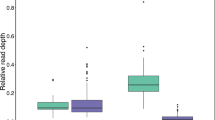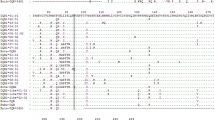Abstract
The chicken MHC B contains two classical class I genes, BF1 and BF2, with the exception of two related haplotypes lacking BF1 due to insertion/rearrangement. In light of functional specialization of BF1 and BF2 molecules, we were interested in evaluating their relative expression at the mRNA level. We evaluated several MHC haplotypes for class I gene expression by RT-quantitative PCR. BF1 transcript levels were approximately two- to fivefold lower than BF2, with the exception of one haplotype in which BF1 expression was very low. To investigate molecular explanations for differences in BF locus or allele expression, we determined nucleotide sequences of Enhancer A and proximal promoter elements of nine different BF1 alleles, as well as their signal peptide sequences. Results showed that all BF1 alleles exhibit conservation of most of the identified promoter elements, but divergence from the Enhancer A sequence identified in the more highly expressed BF2 locus. Nonetheless, extensive BF1 allelic polymorphism was found in the promoter region and in the signal peptide, with two strongly separated allelic lineages identified for both. Patterns of promoter lineages, signal peptide lineages, and exon 2 mature protein coding sequences in individual BF1 alleles suggest that recombination among these elements has contributed to diversification of BF1 alleles. Finally, identification of a novel inactivating mutation in one BF1 allele suggests past selective pressure to eliminate BF1 function.







Similar content being viewed by others
References
Bernard PS, Wittwer CT (2000) Homogeneous amplification and variant detection by fluorescent hybridization probes. Clin Chem 46:147–148
Cereb N, Yang SY (1994) The regulatory complex of HLA class I promoters exhibits locus-specific conservation with limited allelic variation. J Immunol 152:3873–3883
Chiang HI, Zhou H, Raudsepp T, Jesudhasan PR, Zhu JJ (2007) Chicken CD69 and CD94/NKG2-like genes in a chromosomal region syntenic to mammalian natural killer gene complex. Immunogenetics 59:603–11
Ewald SJ, Lien YY, Li L, Johnson LW (1996) B-haplotype control of CD4/CD8 subsets and TCR V beta usage in chicken T lymphocytes. Vet Immunol Immunopathol 53:285–301
Fernandez S, Wassmuth R, Knerr I, Frank C, Haas JP (2003) Relative quantification of HLA-DRA1 and DQA1 expression by real-time reverse transcriptase-polymerase chain reaction (RT-PCR). Eur J Immunogen 30:141–148
Fulton JE, Thacker EL, Bacon LD, Hunt HD (1995) Functional analysis of avian class I (BFIV) glycoproteins by epitope tagging and mutagenesis in vitro. Eur J Immunol 25:2069–2076
Gobin SJP, Keijsers V, van Zutphen M, van den Elsen PJ (1998) The role of Enhancer A in the locus-specific transactivation of classical and nonclassical HLA class I genes by nuclear factor κB. J Immunol 161:2276–2283
Guethlein LA, Older Aguilar AM, Abi-Rached L, Parham P (2007) Evolution of killer cell Ig-like receptor (KIR) genes: definition of an orangutan KIR haplotype reveals expansion of lineage III KIR associated with the emergence of MHC-C. J Immunol 179:491–504
Hilleren PJ, Parker R (2003) Cytoplasmic degradation of splice-defective pre-mRNAs and intermediates. Mol. Cell 12:1453–1465
Huang J, Degraves FJ, Gao D, Feng P, Schlapp T, Kaltenboeck B (2001) Quantitative detection of Chlamydia spp by fluorescent PCR in the light cycler. Biotechniques 30:150–157
Janitz M, Mitchison A, Reiners-Schramm L, Lauster R (1997) Polymorphic MHC class II promoters exhibit distinct expression pattern in various antigen-presenting cell lines. Tissue Antigens 49:99–106
Johnson DR (2003) Locus-specific constitutive and cytokine-induced HLA Class I gene expression. J Immunol 170:1894–1902
Juul-Madsen HR, Dalgaard TS, Afanassieff M (2000) Molecular characterization of major and minor MHC class I and II genes in B21-like haplotypes in chickens. Anim Genet 31:252–261
Kaufman J, Milne S, Gobel TW, Walker BA, Jacob JP, Auffray C, Zoorob R, Beck S (1999) The chicken B locus is a minimal essential major histocompatibility complex. Nature 401:923–925
Koch M, Camp S, Collen Tet al (2007) Structures of an MHC class I molecule from B21 chickens illustrate promiscuous peptide binding. Immunity 27:885–899
Kroemer G, Zoorob R, Auffray C (1990) Structure and expression of a chicken MHC class I gene. Immunogenetics 31:405–409
Kumar S, Tamura K, Nei M (2004) MEGA3: Integrated software for Molecular Evolutionary Genetics Analysis and sequence alignment. Briefings in Bioinformatics 5:150-163
Li L, Johnson LW, Livant EJ, Ewald SJ (1999) The MHC of a broiler chicken line: serology, B-G genotypes, and B-F/B-LB sequences. Immunogenetics 49:215–224
Livant EJ, Brigati JR, Ewald SJ (2004) Diversity and locus specificity of chicken MHC B class I sequences. Anim Genet 35:18–27
Livant EJ, Zheng D, Johnson LW, Shi W, Ewald SJ (2001) Three new MHC haplotypes in broiler breeder chickens. Anim Genet 32:123–31
Mansky P, Brown WM, Park JH, Choi JW, Yang SY (1994) The second kappa B element, kappa B2, of the HLA-A class I regulatory complex is an essential part of the promoter. J Immunol 153:5082–90
Martin MP, Pascal V, Yeager M, Phair J, Kirk GD, Hoots K, O'Brien SJ, Anderson SK, Carrington M (2007) A mutation in KIR3DS1 that results in truncation and lack of surface expression. Immunogenetics 59:823–829
McCutcheon JA, Gumperz J, Smith KD, Lutz CT, Parham P (1995) Low HLA-C expression at cell surfaces correlates with increased turnover of heavy chain mRNA. J Exp Med 181:2085–2093
Mitchison NA, Roes J (2002) Patterned variation in murine MHC promoters. Proc Natl Acad Sci USA 99:10561–10566
Moon DA, Veniamin SM, Parks-Dely JA, Magor KE (2005) The MHC of the duck (Anas platyrhynchos) contains five differentially expressed class I genes. J Immunol 175:6702–6712
Pando MJ, Gardiner CM, Gleimer M, McQueen KL, Parham P (2003) The protein made from a common allele of KIR3DL1 (3DL1*004) is poorly expressed at cell surfaces due to substitution at positions 86 in Ig domain 0 and 182 in Ig domain 1. J Immunol 171:6640–6649
Prestridge DS (1991) SIGNAL SCAN: A computer program that scans DNA sequences for eukaryotic transcriptional elements. CABIOS 7:203–206
Riegert P, Andersen R, Bumstead N, Döhring C, Dominguez-Steglich M, Engberg J, Salomonsen J, Schmid M, Schwager J, Skjødt K, Kaufman J (1996) The chicken beta 2-microglobulin gene is located on a non-major histocompatibility complex microchromosome: a small, G+C-rich gene with X and Y boxes in the promoter. Proc Natl Acad Sci USA 93:1243–1248
Shaw I, Powell TJ, Marston DA, Baker K, van Hateren A, Riegert P, Wiles MV, Milne S, Beck S, Kaufman J (2007) Different evolutionary histories of the two classical class I genes BF1 and BF2 illustrate drift and selection within the stable MHC haplotypes of chickens. J Immunol 178:5744–52
Singer DS, Maguire JE (1990) Regulation of the expression of class I MHC genes. Critical Reviews in Immunology 10(3):235–257
Thomas MC, Chiang C-M (2006) The general transcription machinery and general cofactors. Crit Rev Biochem Mol Biol 41:105–178
Vainio O, Ratcliffe MJ (1984) Proliferation of chicken peripheral blood leukocytes in response to pokeweed mitogen is macrophage dependent. Cell Immunol 85:235–243
Valés-Gómez M, Reyburn HT, Erskine RA, López-Botet M, Strominger JL (1999) Kinetics and peptide dependency of the binding of the inhibitory NK receptor CD94/NKG2-A and the activating receptor CD94/NKG2-C to HLA-E. EMBO J 18:4250–4260
van den Elsen PJ, Holling TM, Kuipers HF, van der Stoep N (2004) Transcriptional regulation of antigen presentation. Current Opinion in Immunology 16:67–75
VandenBussche CJ, Dakshanamurthy S, Posch PE, Hurley CK (2006) A single polymorphism disrupts the killer Ig-like receptor 2DL2/2DL3 D1 domain. J Immunol 177:5347–5357
Vilches C, Parham P (2002) KIR: Diverse, rapidly evolving receptors of innate and adaptive immunity. Annu Rev Immunol 20:217–251
Vincent R, Louis P, Gongora C, Papa I, Clot J, Eliaou J-F (1996) Quantitative analysis of the expression of the HLA-DRB genes at the transcriptional level by competitive polymerase chain reaction. J Immunol 156:603–610
Wallny HJ, Avila D, Hunt LG, Powell TJ, Riegert P, Salomonsen J, Skjødt K, Vainio O, Vilbois F, Wiles MV, Kaufman J (2006) Peptide motifs of the single dominantly expressed class I molecule explain the striking MHC-determined response to Rous sarcoma virus in chickens. Proc Natl Acad Sci U S A 103:1434–1439
Wang C, Gao D, Vaglenov A, Kaltenboeck B (2004) One-step real-time duplex reverse transcription PCRs simultaneously quantify analyte and housekeeping gene mRNAs. Biotechniques 36(508–516):518–519
Wong ML, Medrano JF (2005) Real-time PCR for mRNA quantitation. Biotechniques 39:75–85
Zoeller B, Ozato K, Kroemer G, Auffray C, Jungwirth C (1992) Interferon induction of chicken MHC class I gene expression: Phylogenetic conservation of the interferon-responsive element. Virology 191:141–149
Acknowledgments
This work was supported by an AAES Foundation Grant from Auburn University, and by Animal Health and Disease Grants from the Auburn University College of Veterinary Medicine. The authors thank Ms. Xichun Yan and Mr. Steven Martin for technical assistance, and Dr. Vicky van Santen for critical reading of the manuscript.
Author information
Authors and Affiliations
Corresponding author
Rights and permissions
About this article
Cite this article
O’Neill, A.M., Livant, E.J. & Ewald, S.J. The chicken BF1 (classical MHC class I) gene shows evidence of selection for diversity in expression and in promoter and signal peptide regions. Immunogenetics 61, 289–302 (2009). https://doi.org/10.1007/s00251-008-0354-7
Received:
Accepted:
Published:
Issue Date:
DOI: https://doi.org/10.1007/s00251-008-0354-7




